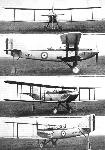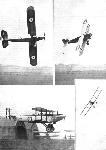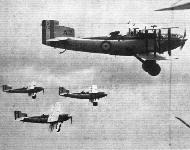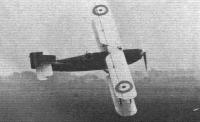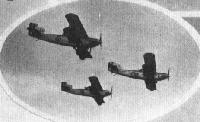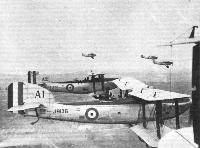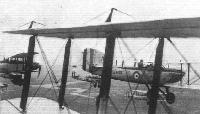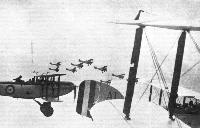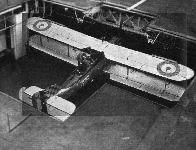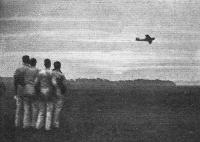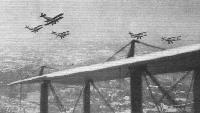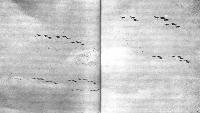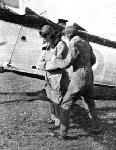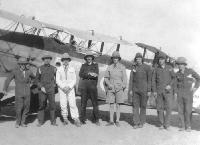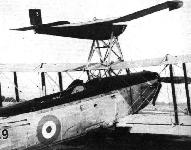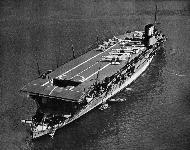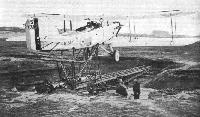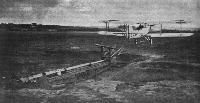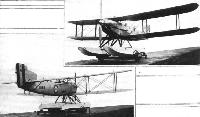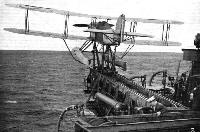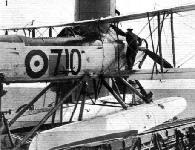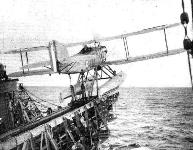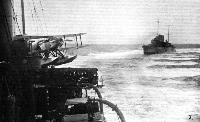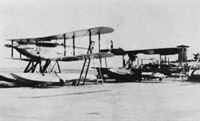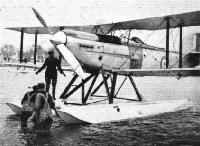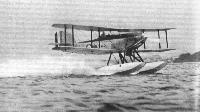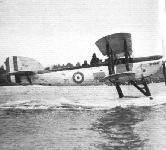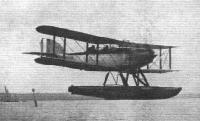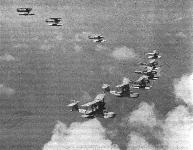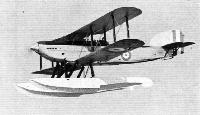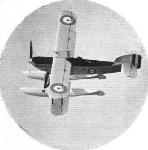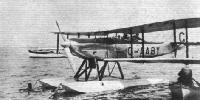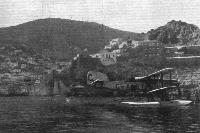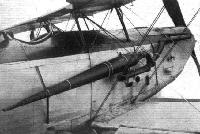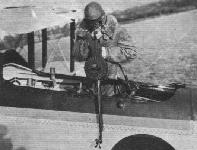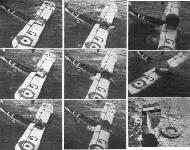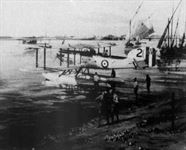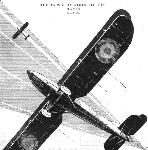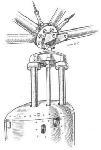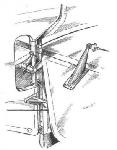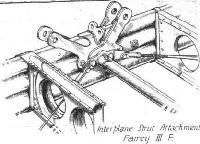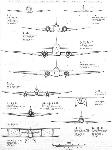
Описание
Страна : Великобритания
Год : 1926
Самолет-разведчик и самолет общего назначения с экипажем из 2-3 человек
Варианты
- Fairey - Fairey III - 1917 - Великобритания
- Fairey - Fairey IIIF - 1926 - Великобритания
- Fairey - Gordon / Seal - 1931 - Великобритания
Семейство Fairey III
<...>
Обозначение Fairey IIIE, вероятно, не присваивалось ни одной машине, хотя отдельные источники приписывают его цельнометаллическому самолету для радиотехнической разведки. Заключительной и самой многочисленной модификацией стал Fairey IIIF, составивший костяк авиапарка британских ВВС и авиации ВМС в период между двумя мировыми войнами. Планировавшийся как замена Fairey IIID, вариант Fairey IIIF был построен в соответствии со Спецификацией 19/24, которая определяла характеристики двухместного сухопутного многоцелевого самолета для ВВС и трехместного корректировщика огня/разведывательного самолета для авиации ВМС. Прототип поднялся в воздух в марте 1926 года и имел деревянные крылья и деревянно-металлический фюзеляж, но серийные машины отличались уже полностью металлическим фюзеляжем, а поздние варианты - вдобавок и металлическими крыльями. Fairey IIIF строился в четырех основных вариантах, но каждый из них имел несколько подвариантов. Вслед за двумя прототипами последовала предсерийная партия из 10 самолетов, британская морская авиация получила 352 самолета, из которых первые 50 включали самолеты предсерийного заказа и 40 самолетов Fairey IIIF Mk I с двигателями Napier Lion VA, а остальная партия включала 33 самолета Fairey IIIF Mk II и 269 самолетов Fairey IIIF Mk III различных модификаций, но все - с двигателями Lion XIA.
Британские ВВС получили 243 самолета - все их варианты имели обозначение Fairey IIIF Mk IV. Первые поступившие в ВВС самолеты пришли из предсерийного заказа для ВМС, шесть самолетов были переданы в 1927 году в 47-ю эскадрилью в Хартуме (для замены самолетов Bristol Fighter). Первыми самолетами, построенными специально для ВВС, стали 43 машины моделей Mk IV и Mk IVCM, в январе 1928 года они были поставлены в 207-ю эскадрилью, дислоцированную в Истчёрче - для замены старых DH.9A.
Самолеты Fairey IIIF выполнили ряд рекордных полетов, но постепенно им на смену пришел Fairey Gordon - оснащенный звездообразным двигателем вариант, изначально известный как Fairey IIIF Mk V. Авиация британских ВМС получила первый Fairey IIIF в 1928 году, он поступил в 440-й отряд (звено) на смену Fairey IIID. После этого 12 авиаотрядов заменили самолетами Fairey IIIF более старые Avro Bison, Blackburn Blackburd и Ripon. Самолеты состояли на вооружении авиаотрядов всех британских авианосцев того времени и дислоцировались на каждой авиабазе морской авиации, а в варианте поплавкового гидросамолета - находились на вооружении оснащенных катапультами линейных кораблей и крейсеров.
Самолеты также приняли участие в различных экспериментах, одним из наиболее интересных стало переоборудование трех самолетов для автоматического управления или радиоуправления при использовании в качестве самолета-мишени для тренировки артиллерийских расчетов. Под обозначением Queen IIIF первые два самолета были запущены с катапульты британского авианосца "Вэлиант" в январе и апреле 1932 года, но оба потерпели аварию после 18 и 25 секунд полета, соответственно. А вот третий самолет успешно поднялся в воздух в сентябре 1932 года, а в январе 1933 года он был запущен в свой первый полет как мишень - также успешно. Самолет Queen IIIF выжил - флотские артиллеристы, потратив два часа и весь боезапас, так и не смогли сбить его. Однако в мае 1933 года британские моряки все же подтвердили свое высокое мастерство - после 20 минут стрельбы самолет-мишень был сбит на высоте 2440 м неподалеку от Мальты.
Оснащенный поплавками Fairey IIIF с ноября 1932 года стали заменять на Hawker Osprey, перевооружение было закончено к 1935 году. Остальные Fairey IIIF с 1933 года стали заменяться на Fairey Seal - принятый на вооружение британских ВМС аналог самолета Gordon. Известны следующие экспортные поставки самолетов Fairey IIIF: три машины в Авиакорпус ирландской Армии, шесть - в Аргентину, две - в Новую Зеландию, десять - в Грецию и одну - в Чили. На самолетах Fairey IIIF устанавливались различные двигатели, в том числе - звездообразный Armstrong Siddeley Jaguar VI мощностью 460 л. с. (343 кВт) и двигатель с водяным охлаждением Lorraine 12Ed мощностью 450 л. с. (336 кВт), которым оснащались самолеты для Аргентины. На них позднее были установлены звездообразные двигатели Armstrong Siddeley Panther VI мощностью 550 л. с. (410 кВт). Другими двигателями, устанавливавшимися в экспериментальных целях, были Rolls-Royce Kestrel II мощностью 635 л. с. (474 кВт), Panther IIА мощностью 525 л. с. (391 кВт), Bristol Jupiter VIII мощностью 520 л.с. (388 кВт) и Napier Culverin аналогичной мощности, а также выпускавшийся по лицензии дизельный двигатель Junkers Jumo 205C.
Несколько Fairey IIIF эксплуатировались в гражданской авиации, один из них - модель Mk IIIM - в 1934 году принимал участие в гонках на приз Мак-Робертсона на маршруте из Великобритании в Австралию. Самолет остался в Австралии, а в 1936 году был перерегистрирован в Новой Гвинее. В 1930 году два самолета Mk IIIM были проданы авиакомпании "Air Survey Co. Ltd", но в том же году один из них был потерян, а другой продолжал аэрофотосъемку до 1934 года.
ТАКТИКО-ТЕХНИЧЕСКИЕ ХАРАКТЕРИСТИКИ
Fairey IIIF Mk IIIM/B (гидросамолет)
Тип: самолет-разведчик и самолет общего назначения с экипажем из 2-3 человек
Силовая установка: один W-образный ПД Napier Lion XIA мощностью 570 л. с. (425 кВт)
Летные характеристики: макс. скорость на высоте 3050 м - 209 км/ч; набор высоты 1525 м - за 6 мин 42 с; практический потолок 6095 м; продолжительность полета 4 часа
Масса: пустого 1779 кг; максимальная взлетная 2858 кг
Размеры: размах крыла 13,94 м; длина 10,82 м; высота 4,26 м; площадь крыльев 41,20 м2
Вооружение: один стреляющий вперед 7,7-мм пулемет Vickers в передней части фюзеляжа и один наводимый 7,7-мм пулемет Lewis для обороны задней полусферы (в задней кабине), плюс до 263 кг вооружений на трех подкрыльевых узлах подвески - в основном две 113-кг бомбы, или две 104-кг бомбы, или четыре 51-кг бомбы, и в каждом варианте - плюс еще четыре 9,1-кг бомбы
Описание:
- Семейство Fairey III
- Flight, July 1928
THE FAIREY III F - Flight, June 1929
BRITISH AIRCRAFT AT OLYMPIA
Фотографии
-
Air Enthusiast 2006-03 / The Roundels File
Регистрационный номер: S1141 [3], SR1141 [3] Fairey IIIF Mk.I S1141 (c/n F682) '4' of Cape Flight, Aboukir, Egypt, circa 1927. Built for the Fleet Air Arm but issued to the Cape Flight prior to service, it was used for flights to and from Cape Town January to May 1927. Note RAF Ensign and Squadron Leader's rank pennant on mast aft of rear cockpit. After the flight, it was rebuilt at Aboukir becoming SR1141. Went on to serve with 47 Squadron at Khartoum, Sudan, and finally (last recorded in late 1928) was with 45 Squadron at Helwati, Egypt.
-
Aeroplane Monthly 1994-04 / P.Jarrett - Fairey IIIF (2)
Регистрационный номер: SR1171 Gordon SR1171 N2 of A Flight, 45 Sqn, 1930
-
Aeroplane Monthly 1994-04 / P.Jarrett - Fairey IIIF (2)
Регистрационный номер: J9136 [4] Gordon J9136 A1 of A Flight, 207 Sqn, 1931
-
Air Enthusiast 2006-03 / The Roundels File
Регистрационный номер: J9647 [2] Fairey IIIF Mk.IV J9647 (c/n F1149) 'A3' of 207 Squadron, Bircham Newton, Norfolk, circa 1931. Later coded 'A1', in 1933 it was converted to Gordon status and stayed with the unit - this time as 'C3' - to circa 1935.
-
Aeroplane Monthly 1994-04 / P.Jarrett - Fairey IIIF (2)
Регистрационный номер: J9800 Gordon J9800 of A Flight, 35 Sqn, June 1930
-
Air Enthusiast 2006-03 / The Roundels File
Регистрационный номер: K1115 [2] Fairey IIIF Mk.IV (GP) K1115 (c/n F1295) of 24 (Communications) Squadron, Northolt, London, July 1931. Issued to 24 Squadron July 9, 1930, the unit moved to Hendon, London, July 1933. Retired, becoming ground instructional airframe 689M in July 1935.
-
Aeroplane Monthly 1994-04 / P.Jarrett - Fairey IIIF (2)
Регистрационный номер: K1169 Gordon K1169 C1 of C Flight, 207 Sqn, 1931
-
Aeroplane Monthly 1994-04 / P.Jarrett - Fairey IIIF (2)
Регистрационный номер: S1205 Gordon S1205 B1 of B Flight, 207 Sqn, 1929
-
Air Enthusiast 2006-03 / The Roundels File
Регистрационный номер: J9066 [2] Fairey III Mk.IVC (GP) J9066 (c/n F986) of 8 Squadron, Khormaksar, Aden, 1929. It was issued to 8 Squadron, in landplane form, in late 1928. Converted to seaplane in January 1929. No.8 Squadron used IIIFs up to 1935.
-
Air Enthusiast 2006-03 / The Roundels File
Регистрационный номер: S1386 [2] Fairey IIIF (Intermediate) S1386 (c/n F1248) 'S' of 202 Squadron, Kalafrana, Malta, 1935. Taken on charge by 202 Squadron on October 1, 1930. Hit by Fairey Swordfish floatplane K5943 of 824 Squadron while water-taxying, October 10, 1936, and struck off charge.
-
Aeroplane Monthly 1994-03 / P.Jarrett - Fairey IIIF (1)
Регистрационный номер: N198 [4] The first prototype of the IIIF was N198. This aircraft was first flown as a landplane on March 19, 1926. The improvements wrought by careful streamlining are obvious.
-
Aeroplane Monthly 1994-03 / P.Jarrett - Fairey IIIF (1)
Регистрационный номер: N225 [4] The second IIIF prototype, N225, had an all-metal airframe and thus served as the prototype for the Mk IIIM. It is seen at Martlesham Heath with an experimental fin and rudder of interim design.
-
Air Enthusiast 2006-03 / The Roundels File
Регистрационный номер: N225 [4] Carrying just its constructor's number, F890, on the rear fuselage, the second prototype all-metal Fairey IIIF N225 first flew on March 2, 1927 with an experimental fin and rudder.
-
Flight 1927-05 / Flight
Регистрационный номер: S1141 [3], S1144, SR1141 [3] THE SERVICE AFRICAN FLIGHT: The four Fairey III.F biplanes, fitted with Napier "Lion" engines, on which the R.A.F. flight from Cairo to Cape Town and back is being carried out under the command of Air-Commodore Samson, C.M.G., D.S.O., A.F.C. Our picture shows the machines starting from Heliopolis on March 30. They reached the Cape on April 21, and are scheduled to start the return journey on May 9, arriving back at Cairo on May 22.
-
Aviation Historian 11 / M.Willis - From Farmer to Test Pilot /Duncan Menzies/ (1)
Регистрационный номер: SR1141 [3], S1141 [3] Three Fairey IIIFs of No 47 Sqn at Kassaia, Sudan. The “SR” serials signify that the original wooden airframes had been rebuilt with metal parts, more suitable for the tropical climate.
-
Aeroplane Monthly 1994-03 / P.Jarrett - Fairey IIIF (1)
Регистрационный номер: S1147 [2] The true prototype of the RAF’s general-purpose version was the wooden, Lion XI-powered S1147, which was flown at the A&AEE in March and May 1927 and was later used for spinning tests by the RAE.
-
Air Enthusiast 2006-03 / The Roundels File
Регистрационный номер: S1147 [2] Delivered in 1926, S1147 was converted to a two-seat general purpose (GP) machine. It was serving with A&AEE by April 1927 and then moved to Andover, Hampshire, for trials with 12 Squadron in mid-1927. In 1928 it carried out deck-landing tests on HMS 'Furious' and moved to the RAE in May that year. It was back at A&AEE by March 1932.
-
Flight 1927-05 / Flight
Регистрационный номер: S1148 [2] THE FAIREY IIIF MACHINE WITH NAPIER "LION" ENGINE: The R.A.F. Flight from Cairo to the Cape and back, which has just been successfully concluded, was carried out on machines of this type. The IIIF has quite a resemblance to the Fairey "Fox."
-
Flight 1927-05 / Flight
Регистрационный номер: S1148 [2] SPEED AND MANOEUVRABILITY: These views of the Fairey IIIF in flight, piloted by Capt. Norman Macmillan, give some idea of the way this machine can be "thrown about." The Cairo-Cape-Cairo flight was carried out by four machines of this type.
-
Air Enthusiast 2006-03 / The Roundels File
Регистрационный номер: S1182 Fairey IIIF Mk.I S1182 was fitted initially with a more angular fin. It joined 443 Flight on HMS 'Furious' in late 1927, transferring to 207 Squadron at Eastchurch, in January 1928. It changed unit, but not base in April 1929 when it transferred to the Coast Defence Co-operation Flight. It moved to Hamble, Hampshire, in November 1929 for conversion by Fairey to Mk.III status. By September 1920 it was with 446 Flight on HMS 'Courageous'; by February 1934 with 820 Squadron at Gosport, Hampshire, and finally with 822 Squadron on HMS 'Furious' by November 1934. It crashed on 'Furious'; on March 3, 1936 when its arrester hook failed and was written off.
-
Flight 1932-06 / Flight
Регистрационный номер: S1202 [3] -
Flight 1931-01 / Flight
One of the Fairey "IIIF" (Napier "Lion") bombers of the R.A.F. Cairo-Cape flight (1929), at Cape Town. This actual machine crashed on the return flight.
-
Flight 1928-06 / Flight
FAIREY III F.: General-Purpose two-seater, with Napier "Lion" Engine.
-
Flight 1929-03 / Flight
The Fairey IIIF General Purpose Machine, Napier "Lion" engine.
-
Flight 1930-06 / Flight
A FLIGHT OF FAIREY IIIF AEROPLANES: Note that the leading machine has its flaps down, and that as a result the fuselage is at a small negative angle.
-
Flight 1928-10 / Flight
THE R.A.F. DISPLAY FOR A SULTAN: On October 11 the R.A.F. gave a Display at Hendon in honour of the Sultan of Muscat. Three Fairey Day Bombers, of No. 207, "Fly Past."
-
Air Enthusiast 2006-03 / The Roundels File
Регистрационный номер: J9061 Fairey IIIF Mk.IVC(GP) J9061 was modified for VIP use and joined 24 Squadron at Northolt, London, in May 1928. It force-landed in Yorkshire in May 1931 and was struck off charge.
-
Flight 1928-07 / Flight
Регистрационный номер: J9068 -
Flight 1928-06 / Flight
Регистрационный номер: J9136 [4], S1202 [3] AT HENDON: This is view taken from a Fairey IIIF machine over Hendon of the R.A.F. machines practising during the week for the Display on June 30. Close-up view of the Fairey IIIF's taken from the starboard machine of the Flight by our photographer.
-
Flight 1928-06 / Flight
Регистрационный номер: J9136 [4] Rehearsing for the R.A.F. Display: Struts interfere somewhat with the view, but nevertheless quite a number of Fairey III F's may be seen flying over the Welsh Harp, with a Hawker "Horsley" looking very small in the background.
Другие самолёты на фотографии: Hawker Horsley / Dantorp - Великобритания - 1925
-
Flight 1928-06 / Flight
Регистрационный номер: J9136 [4] AT HENDON: This is view taken from a Fairey IIIF machine over Hendon of the R.A.F. machines practising during the week for the Display on June 30. Fairey IIIF's are in the foreground and Flights of Hawker "Horsleys" in the distance.
Другие самолёты на фотографии: Hawker Horsley / Dantorp - Великобритания - 1925
-
Air Enthusiast 2006-03 / The Roundels File
Регистрационный номер: J9164 [2] Fairey IIIF Mk.IVC/M J9164 joined A&AEE in November 1928 for performance assessment of wing slots (illustrated). From February 1929 it undertook more trials with 22 Squadron, which shared Martlesham Heath with A&AEE.
-
Air Enthusiast 2006-03 / The Roundels File
Регистрационный номер: J9164 [2] Fitted with metal wings in September 1929, J9164 rejoined A&AEE that October and was given long-range tanks (illustrated) for endurance trials. It was despatched to Sealand, Wales, for packing and shipping to Aboukir, Egypt. It went on to serve with 45 Squadron at Helwan, Egypt, from December 1931 and 47 Squadron at Khartoum, Sudan, front May 1933 to April 1934. It was struck off charge in 1936.
-
Air-Britain Aeromilitaria 1981-04
Регистрационный номер: J9166 A Fairey IIIF of No.8 Squadron at Khormaksar, Aden, J9166. It is interesting in that the figure in white in the rear cockpit is Amy Johnson, who passed through Aden on her way back from her solo flight to Australia in May 1930. In view of her reputation for being unable to land an aircraft properly, it seems unlikely that they allowed her to fly it! The parasol held by the fourth person from the left was not standard RAF issue, even in Aden. Local colour is added by the camel in the background.
-
Air Enthusiast 2006-03 / The Roundels File
Регистрационный номер: J9174 Built as a Mk.IVM J9174 was fitted with a Rolls-Royce F.XIIA (Kestrel to be) and first flew on December 5, 1928, becoming a IIIF (Special). It was issued to the Royal Aircraft Establishment at Farnborough, Hampshire, on January 4, 1929. Later it was re-engined with a F.XIIS and it appeared at the RAF Pageant at Hendon, London, in June 1933. It was retired in early 1936, becoming a catapult loading instructional airframe at RAE.
-
Flight 1930-11 / Flight
Регистрационный номер: J9640 Fairey III F general purpose machine. (Napier Lion engine.)
-
Aviation Historian 21 / R.Shaw - The Grand Tour
Регистрационный номер: J9655 [2] Keeping the Victorias of No 216 Sqn company during the 1934 East African tour were four Fairey IIIFs of No 45 Sqn, based at Helwan near Cairo. The IIIF was powered by a Napier Lion engine, and it was presumably for the Faireys that a spare Lion engine was carried beneath the starboard wing of No 2 Victoria for part of the 1934 tour.
-
Aeroplane Monthly 1994-05 / O.Thetford - Fairey IIIF and Gordon in service /By day and by night/
Регистрационный номер: J9655 [2] Fairey IIIF Mk IV J9655, a 45 Sqn aircraft based at Aboukir between 1930 and 1933. It was rebuilt as a Gordon and was finally struck off RAF charge in February 1937.
-
Aeroplane Monthly 1994-05 / O.Thetford - Fairey IIIF and Gordon in service /By day and by night/
Регистрационный номер: J9158, J9665, J9675 Fairey IIIF Mk IVs of B Flight, 8 Sqn, in line abreast in June 1931. J9665 later crashed into the bank of the River Nile.
-
Aeroplane Monthly 1994-05 / O.Thetford - Fairey IIIF and Gordon in service /By day and by night/
Регистрационный номер: J9805 J9805 was a Fairey IIIF Mk IV(GP), probably with 47 Sqn.
-
Aeroplane Monthly 1994-05 / O.Thetford - Fairey IIIF and Gordon in service /By day and by night/
Регистрационный номер: K1115 [2] Fairey IIIF Mk IV K1115 was delivered to the RAF in February 1930. It served with 24 Sqn and became instructional airframe 689M in July 1935.
-
Aeroplane Monthly 1994-02 / Personal album. Military
Регистрационный номер: K1118 Pictured at RAF Tangmere in 1933 is Fairey IIIF Mk IV K1118, delivered to 24 Sqn at RAF Northolt in February 1930. This communications and training squadron used a variety of aircraft for VIP flights. K1118 was finally struck off RAF charge in 1936.
-
Air Enthusiast 2006-03 / The Roundels File
Регистрационный номер: S1189 [2] S1189 was built as a IIIF Mk.I but was rebuilt to feature the rounded fin. It was with 446 Flight at Leuchars, Scotland, by November 1927 and despatched to HMS 'Courageous'; transferring to 443 Flight on HMS 'Furious' by March 1929, wearing the code '36'. Conversion to Mk.III followed and S1189 was back on 'Furious' still as '36', but this time with 445 Flight, then 821 Squadron. Final service use came with the School of Naval Co-operation at Lee-on-Solent before it was presented to the Royal Hellenic Navy in mid-1936.
-
Flight 1937-06 / Flight
Регистрационный номер: S1189 [2] The illustration shows a Fairey III.F in the hold of the aircraft carrier H.M.S. "Courageous." As an indication of their wide adoption for Fleet Air Arm operation, 12 units out of a total of 18 of this branch of the Royal Air Force are equipped with Fairey aircraft.
-
Aeroplane Monthly 1994-04 / P.Jarrett - Fairey IIIF (2)
Регистрационный номер: S1320 [4] VERSATILITY: The Fairey IIIF, of which this is an aerial photograph, is produced as a General Purpose aircraft, as a Bomber, as a Fleet Reconnaissance three-seater, and as a seaplane. Moreover, it has been fitted successfully with a variety of engines, water-cooled and air-cooled. This particular one has a Napier "Lion."
Fairey IIIF Mk III S1320 displays the retractable undernose radiator and the trough for the forward-firing Vickers machine-gun. -
Flight 1930-06 / Flight
Регистрационный номер: S1320 [4] THE FAIREY III F.: In addition to its use as a Day Bomber, the III F. is produced as a General Purpose aircraft, and as a twin-float seaplane with many functions. The engine is a Napier "Lion."
-
Мировая Авиация 123
Регистрационный номер: S1320 [4] Фирма "Fairey" строила модель IIIF из различных материалов. Обозначение "M" у Fairey IIIF Mk IIIM означало цельнометаллическую конструкцию.
-
Aeroplane Monthly 1994-04 / P.Jarrett - Fairey IIIF (2)
Регистрационный номер: S1320 [4] Another inflight study of IIIF Mk IIIM S1320. The long, faired fuselage and the closely-cowled engine gave the IIIF far more elegant lines than its forebears.
-
Aeroplane Monthly 1994-04 / P.Jarrett - Fairey IIIF (2)
Регистрационный номер: S1354 Fairey IIIF Mk IIIM S1354 is representative of the three-seat variant for the Fleet Air Arm. Note the slat mechanism on the upper wing leading edge, and the cutout in the rear outer interplane strut which locked on to an attachment on the tailplane when the wings were folded.
-
Aeroplane Monthly 1977-09 / Personal album
Регистрационный номер: S1356 [2] A visit to Abu Suier by a batch of aircraft from a Fleet Air Arm carrier. In the foreground is Fairey IIIF Mk III S1356, powered by the trusty Napier Lion (note the windsock on the rudder). The other five aircraft are Blackburn Ripon IIC torpedo bomber/reconnaissance aircraft, also Lion-powered.
Другие самолёты на фотографии: Blackburn Ripon / T.5 - Великобритания - 1926
-
Aeroplane Monthly 1976-12 / Personal album
Регистрационный номер: S1486 Fairey IIIF Mk IIIB three-seat spotter reconnaisance aircraft S1486, c/n F1329, heads for the nets at a pace. The pilot is identified as "Rupert Hogan”. This view illustrates the revised, rounded fin and rudder fitted to later variants of the type. The IIIB was of all-metal construction, strengthened for catapulting and powered by a Napier Lion XIA of 570 h.p.
-
Air-Britain Aeromilitaria 1983-01
Регистрационный номер: S1487 Fairey IIIF S1487(86) of No.825 Squadron over HMS Eagle
-
Air-Britain Aeromilitaria 1981-03
Регистрационный номер: S1514 S1514 was another Fairey IIIF which had a varied career, ending up at the Royal Aircraft Establishment at Farnborough before becoming a catapult dummy. There are no details as to when this photograph was taken but the unarmed state of the rear cockpit suggests that it was in its final days when the shutter clicked.
-
Aeroplane Monthly 1981-04 / P.Heath - Tales of a target-tower
Регистрационный номер: S1522 The author makes his first deck landing, in Fairey IIIF, S1522, on Courageous.
-
Air-Britain Aeromilitaria 1980-04
Регистрационный номер: S1794 Fairey IIIF Mk.III S1794 running-up at Brooklands
-
Air-Britain Aeromilitaria 1983-01
Регистрационный номер: S1821 Fairey IIIF S1821 of No.824 Squadron comes to a halt. The chocks are rapidly positioned, just in case!
-
Air-Britain Aeromilitaria 1981-03
Регистрационный номер: S1845 [3] S1845 is another illustration of S-series aircraft listed in AM.4/80. This Fairey IIIF dual control trainer was No.9 at the main FAA training base at Leuchars in 1932. Main difference between the IIIF DC and the standard FAA aircraft was the two forward-facing cockpits, the rear replacing the bathtub which normally housed the observer and gunner.
-
Aeroplane Monthly 1994-03 / P.Jarrett - Fairey IIIF (1)
Регистрационный номер: S1847 [2] IIIF Mk III S1847 is representative of the dual-control trainer (DC) version. Conversion to this form was accomplished by removing the usual observer’s equipment, installing a conversion “kit” and fitting a special cowling.
-
Air Enthusiast 2006-03 / The Roundels File
Регистрационный номер: S1847 [2] A catapult-capable Mk.IIIB(DC) dual-control trainer, S1847 was first issued to 'C' Flight at the RAF Training Base, Leuchars. The unit was later renamed 1 Flying Training School. By April 1, 1935 it was in use on the catapult installed at Leuchars. On August 6, 1937, S1847 was hit by 501 (County of Gloucester) Squadron Hawker Hart K3017 during a landing accident at Leuchars on August 6, 1937. Deemed beyond economical repair, S1847 was scrapped while K3017 survived to serve another day.
-
Flight 1934-10 / Flight
DAWN OF ADVENTURE: A striking impression captured by the camera as the sun broke through at Mildenhall. The machine is F.O. Davies's and Lt. Com. Hills' Fairey III F.
-
Flight 1935-02 / Flight
The Fairey III F's (Napier "Lion") of No. 45 (Bomber) Squadron flying over the Pyramids while rehearsing for the Middle East Display.
-
Flight 1928-06 / Flight
Rehearsing for the R.A.F. Display: This photograph shows several Fairey III F. machines making a turn in formation.
-
Flight 1928-10 / Flight
THE R.A.F. DISPLAY FOR A SULTAN: On October 11 the R.A.F. gave a Display at Hendon in honour of the Sultan of Muscat. Our illustration shows No. 207 Bombing Squadron in close formation;
-
Flight 1928-07 / Flight
AIR FORCE DISPLAY: Fairey IIIF's at drill movements in formation. Each Squadron passed in succession from different directions performing similar drill orders
-
Flight 1930-07 / Flight
54 Machines flying past: Three Fighter Squadrons on Siskins, one Bomber Squadron on Foxes, and two Bomber Squadrons on III F's.
Другие самолёты на фотографии: Armstrong Whitworth Siskin - Великобритания - 1921Fairey Fox - Великобритания - 1925
-
Flight 1930-07 / Flight
EVOLUTION BY THREE DAY BOMBER SQUADRONS: Fairey Foxes in the lead, two Fairey III squadrons on the wings. The Foxes kept the better formation.
Другие самолёты на фотографии: Fairey Fox - Великобритания - 1925
-
Flight 1930-08 / Flight
Blue Siskins intercept a raid on Andover by Fairey III F.'s, but the bomb signal (the puff of smoke on the right of the picture) has been dropped.
Другие самолёты на фотографии: Armstrong Whitworth Siskin - Великобритания - 1921
-
Flight 1931-07 / Flight
BIG GAME HUNTING FROM THE AIR. HERE WE SEE THE HUNTER, IN A FAIREY IIIF, TAKING A SHOT AT THE SOFT ROE FLOPPITY - ONE OF SEVERAL FIERCE AND WEIRD MONSTERS WHICH "ESCAPED" FROM LOCAL ZOO
-
Flight 1932-06 / Flight
"THE FIRES OF FATE": R.A.F. Co-operation has been secured by British International Pictures, Ltd., for a film they are making in Egypt with the above title. This photograph shows a Fairey III F. flying over a detachment of the Camel Corps.
-
Flight 1932-05 / Flight
A FORMATION OF AIRCRAFT TYPES USED FOR INSTRUCTION AT THE CENTRAL FLYING SCHOOL: From left to right, Gamecock, Atlas, Moth, III.F, Avro-Lynx, Siskin and Bulldog.
Другие самолёты на фотографии: Armstrong Whitworth Atlas / Ajax - Великобритания - 1925Armstrong Whitworth Siskin - Великобритания - 1921Avro Avro 504N - Великобритания - 1920Bristol Bulldog - Великобритания - 1927De Havilland Gipsy Moth / Moth X - Великобритания - 1928Gloster Gamecock - Великобритания - 1925
-
Flight 1931-07 / Flight
A MIXED GRILL: A formation of seven different types over Wittering, viz., "Gamecock," "Atlas," "Moth," "Fairey III F," "Avro-Lynx," "Siskin," and "Bulldog."
Другие самолёты на фотографии: Armstrong Whitworth Atlas / Ajax - Великобритания - 1925Armstrong Whitworth Siskin - Великобритания - 1921Avro Avro 504N - Великобритания - 1920Bristol Bulldog - Великобритания - 1927De Havilland Gipsy Moth / Moth X - Великобритания - 1928Gloster Gamecock - Великобритания - 1925
-
Aeroplane Monthly 1994-12 / G.Wansbrough-White - What's in a name? (2)
THE STAGE SET: This aerial photograph of the Royal Air Force Display machines assembled in the operational park at Hendon forms a fitting introduction to the pictures, in the ensuing pages, of the Display in progress. There are eight monoplanes in the assembly - Ansons (third row) and Clouds (fifth).
Line-up of about 130 1936 RAF Display participants - all biplanes except for the Ansons and Saro Cloud amphibians.
The stage is set for the 1936 RAF Display at Hendon. The monoplanes (Ansons and Saro Clouds) are totally outnumbered by the biplanes including Heyfords, Bulldogs, Gauntlets, Fairey IIIFs, Harts, Hinds, Tiger Moth, Overstrands etc, etc. This entire area has since disappeared beneath a sea of bricks and concrete.Другие самолёты на фотографии: Avro Anson / Type 652 - Великобритания - 1935Boulton Paul Overstrand / P.75 - Великобритания - 1933Bristol Bulldog - Великобритания - 1927De Havilland Tiger Moth / D.H.82 - Великобритания - 1931Gloster Gauntlet - Великобритания - 1929Handley Page Heyford / H.P.38 / H.P.50 - Великобритания - 1930Hawker Hart - Великобритания - 1928Hawker Hind - Великобритания - 1934Saunders-Roe Cloud / A.19 - Великобритания - 1930
-
Air-Britain Aeromilitaria 1978-03
At the risk of appearing to over-emphasise airfields in this issue, the back cover photograph has been selected to illustrate one of the Royal Air Force's most famous overseas stations.
Lying between Cairo and the Suez Canal, Heliopolis was retained as a permanent station after the end of World War One when many Egyptian airfields closed down. It is perhaps best known as the home of the Victoria and Valentia bomber-transports which so typified the activities of the RAF in the Middle East between the wars. It also was a staging post on Imperial Airways routes to South Africa and the Far East.
In layout, it was typical of desert airfields in having its buildings clustered together within a perimeter fence. By tradition, the local inhabitants were assumed to be able to purloin anything not embedded in concrete, a much greater menace than air attack. At night, the gates were closed to leave only the landing ground open to stray visitors. In the photograph can be seen Fairey IIIFs and Atlases parked outside the wire while beside the large hangar sits a D.H.66 tri-motor of Imperial Airways. The three smaller hangars nearest to the large hangar were used by the airline and the RAF fence neatly loops back to allow them to guard their own property!
In the left background, safely isolated from the main camp, is the ammunition dump in its revetment and wired in separately.
The photograph was taken on 8 March 1929 by No.208 (Army Cooperation) Squadron.Другие самолёты на фотографии: Armstrong Whitworth Atlas / Ajax - Великобритания - 1925De Havilland Hercules / D.H.66 - Великобритания - 1926
-
Flight 1930-06 / Flight
ROYAL TRANSPORT: The Wapiti used by Prince George is on the right with the escort machines lined up alongside.
Другие самолёты на фотографии: Westland Wapiti - Великобритания - 1927
-
Aeroplane Monthly 1978-05 / C.Baker - A Fairey for Athens
The Fairey, Breguet and Letov-Smolik at Tatoi Aerodrome, Athens.
Другие самолёты на фотографии: Breguet Br.19 - Франция - 1922Letov S-16 - Чехословакия - 1926
-
Flight 1929-01 / Flight Advertisements
Регистрационный номер: J9173 [2] The extensive adaptability of the Fairey III.F. aircraft is already well-known. The photograph, however, shows this adaptability extended to a still further degree, by the variety of engines that can be installed, each III.F. aircraft being fitted with a different type of engine, namely, Napier "Lion" XI, Rolls-Royce "F" type, Bristol "Jupiter" VIII, and the Lorraine 12 Ed. The general utility and high efficiency of the Fairey III.F. is already confirmed by the large numbers in use with the Royal Air Force at home and overseas, and with the Air Forces of the Dominions, and of Foreign Governments.
-
Flight 1928-12 / Flight
Регистрационный номер: J9173 [2] ADAPTABILITY! This picture of four Fairey III.F biplanes is an interesting "study in noses," and also illustrates the adaptability of this machine as regards power plant. Each machine is fitted with a different engine, viz. :- (From left to right) Lorraine Type Ed. 12; Bristol "Jupiter," Series VIII; Napier "Lion XIA"; and Rolls-Royce F.XI.
-
Flight 1928-08 / Flight
SCALE EFFECT! Two views of the Fairey III F (Napier "Lion"), one being of a scale model, and the other being of one of the actual machines recently supplied to the Irish Free State Air Force. Which is which, we leave to our readers to guess. (N.B. - No prize given.)
-
Flight 1932-11 / Flight
SIR GEOFFREY SALMOND: Beside the Fairey III.F in which he flew from Northolt.
-
Flight 1929-06 / Flight
OUR FIRST PRIME MINISTER TO FLY: Mr. Ramsay MacDonald, Prime Minister of the new Government, thanking his pilot on landing at Hendon on June 20 after flying from Lossiemouth in the R.A.F. Fairey IIIF, a distance of 500 miles. He is seen being received by Wing-Commander W. J. Y. Guilfoyle, O.B.E., M.C., q.s. The pilot was Flight-Lieut. H. W. Heslop.
-
Flight 1931-09 / Flight
THE PREMIER IN GERMANY: A short time ago Mr. Ramsay MacDonald visited Berlin by air, and our photograph shows him getting into the Fairey III.F. (Lion) at Tempelhof for the return flight.
-
Aviation Historian 11 / M.Willis - From Farmer to Test Pilot /Duncan Menzies/ (1)
Duncan Menzies (in white overalls) beside a Fairey IIIF in Egypt, probably while he was serving with No 47 Sqn. Moving from Helwan to Khartoum in October 1927, the unit used its Fairey IIIFs to co-operate with the Sudan Defence Force in policing the desert regions of the area.
-
Flight 1937-11 / Flight
Target gliders have been successfully launched from the top centre sections of Fairey IIIF and other aircraft.
-
Flight 1931-06 / Flight
The photograph is unique, as our photographer has caught a III F just as the pilot gave the rudder a final kick to enable him to see the deck before landing. The smoke and hot air from the funnel are apt to cause bumps and bad visibility when coming up astern, and it is necessary to slew the aircraft about somewhat before putting her down in order to get a clear view of the deck.
-
Flight 1930-05 / Flight
A view taken from the bridge, of a Fairey III F just landing on the deck. Astern is the destroyer which always stands by when any flying is in progress; at the side of the deck can be seen the aerial masts now in the lowered position, and also the landing crew standing on the platforms at the side of the deck ready to jump up and hold on to the machine as soon as she comes level with them. In front of the aircraft are the white guiding lines on the deck between which it is always endeavoured to land, and thereby ensure that the best use is made of the width of the deck and also minimise the danger of going overboard or hitting the funnel.
-
Air-Britain Aeromilitaria 1978-02
Aircraft landing on in pre-arrester wire days is a Fairey IIIF spotter-reconnaissance aircraft.
-
Flight 1930-05 / Flight
A III F is landing.
-
Aeroplane Monthly 1981-04 / P.Heath - Tales of a target-tower
A scene aboard HMS Glorious in 1930.
A Fairey III F landing. The landing crew are just running out to hold on to each wing tip, and thus prevent the aircraft slewing toward the ship side. This would not necessarily mean a disaster, as right on the right will be seen the wire netting pallisades which prevent a machine from actually falling into the sea should she slew round. -
Air-Britain Aeromilitaria 1980-04
Fairey Firefly III during trials aboard HMS Glorious
-
Flight 1930-05 / Flight
The series is taken from a cinema film, and are really self-explanatory. The Fairey III F can be seen approaching and finally landing.
-
Air-Britain Aeromilitaria 1983-01
'Eagle' sailing not quite into wind with palisades down and a Fairey IIIF on deck. Note the complex lift shape and the signalling mast over the port side
-
Flight 1931-03 / Flight
H.M. AIRCRAFT CARRIER "EAGLE": This floating aerodrome will be the home, during the Exhibition, of Hawker "Nimrods" and "Ospreys," and Fairey III F's with "Panther" engine, in addition to its normal equipment of Blackburn "Ripons" and Fairey III F's (Napier).
-
Flight 1932-05 / Flight
THE HORNET'S NEST: AN AERIAL VIEW OF THE AIRCRAFT CARRIER "COURAGEOUS." THE MACHINES RANGED ON THE FLYING DECK INCLUDE FAIREY "FLYCATCHERS" AND IIIF'S. NOTE THAT BOTH LIFTS ARE DOWN, PRESUMABLY TO FETCH MORE AIRCRAFT.
Другие самолёты на фотографии: Fairey Flycatcher - Великобритания - 1922
-
Flight 1933-09 / Flight
H.M.S. Furious: The Fairey "3 F" machines of No. 822 (Fleet Spotter Reconnaissance) Squadron ready to take off from the deck of the carrier. Note the smoke issuing from below the flying deck.
-
Air-Britain Aeromilitaria 1978-02
Ten Fairey IIIFs await launching as the plane-guard destroyer tucks in to the port quarter to await customers, pending the invention of a practical helicopter. This view illustrates well the dangers from turning propellers on a congested flightdeck.
-
Air-Britain Aeromilitaria 1980-03
Three Fairey III F's and three Fairey Flycatchers lined up on the top flying deck. Here again one can get a good idea of the size of this deck, and can see that the landing and taking-off space available is considerably larger than many of the landing fields used by some of our joyriding firms who operate without a constant wind speed over their fields such as can be provided here at will.
Другие самолёты на фотографии: Fairey Flycatcher - Великобритания - 1922
-
Aeroplane Monthly 1976-12 / Personal album
A view of a congested aft deck, with Blackburn Darts, Fairey IIIFs and, in the foreground, a Blackburn Blackburn Mk I in evidence. The unsightly Blackburn was designed for reconnaissance and gunnery fire control, and proved very successful in this role. The engine was a 450 h.p. Napier Lion IIB.
Другие самолёты на фотографии: Blackburn Blackburn / R.1 - Великобритания - 1922Blackburn Swift T.1 / Dart T.2 - Великобритания - 1920
-
Flight 1936-03 / Flight
NOT A STRANGE STREET PROCESSION, as a first glance suggests, but a Royal Marines band playing during inspection on the aircraft carrier Furious. The machines are Fairey III Fs.
-
Flight 1931-02 / Flight
THE "ISLAND" ABEAM: A Fairey IIIF taking off from the deck of H.M.S. "Glorious".
We are looking forward at a Fairey III F which is just taking off away from us. This view shows very clearly that, although the III F has a comparatively large span, she still has plenty of room when abreast the funnel or island, as it is called in this craft. -
Air-Britain Aeromilitaria 1978-02
The photograph of a Fairey IIIF taking-off shows the hangar doors through which the slip flight Flycatchers took off over the bows and between take-offs from the flight-deck above.
-
Aeroplane Monthly 1990-02 / E.Chilton - Flying starts
Регистрационный номер: S1845 [3] Patched and battered-looking Fairey IIIF Mk III S1845 being lowered onto the Leuchars catapult.
-
Aeroplane Monthly 1984-04 / Assisted take-off
Регистрационный номер: S1845 [3] Fairey IIIF S1845 about to be launched from the Leuchars catapult.
-
Flight 1930-10 / Flight
Регистрационный номер: S1317 [2] The catapult with which experiments are being carried out by the Royal Aircraft Establishment at Farnborough. It will be observed from the photograph that the aircraft, a Fairey III F, is supported at four points, and has its tail skid resting in a guide rail. The compressed air is contained in cylinders mounted under the catapult structure, and the ram is in the form of a three-joint telescopic tube.
-
Flight 1930-10 / Flight
Регистрационный номер: S1317 [2] The III F at the moment of leaving the catapult.
-
Aeroplane Monthly 1990-02 / E.Chilton - Flying starts
Crowds at the RAF Leuchars, Fife Empire Air Day in May 1936 watch as a No 1 Training School Fairey IIIF is launched from its catapult
-
Aeroplane Monthly 1994-03 / P.Jarrett - Fairey IIIF (1)
Регистрационный номер: K1726 Representing an assortment of IIIFs used as engine testbeds is K1726, fitted with Napier’s Culverin two-stroke diesel, a licence-built Junkers Jumo V205C, driving a ground-adjustable, variable-pitch three-bladed metal propeller. It underwent tests at the RAE.
-
Aeroplane Monthly 1994-03 / P.Jarrett - Fairey IIIF (1)
Регистрационный номер: N198 [4] The first prototype of the IIIF was N198, seen here at the MAEE, Felixstowe, during tests as a seaplane in 1926.
-
Flight 1927-08 / Flight
Регистрационный номер: N198 [4] A MODERN FAIREY SEAPLANE: Two views of the Fairey III F. seaplane, fitted with a Napier "Lion" engine. This machine is the marine version of the III F. land 'plane type, which was employed on the Cairo-Cape-Cairo Flight this year
-
Aeroplane Monthly 1987-08 / A.Lumsden, T.Heffernan - Per Mare Probare (5)
Регистрационный номер: N198 [4] The Napier Lion-powered prototype Fairey IIIF, N198. It was first flown, as a landplane, on March 19, 1926, and was fitted with floats the following month.
-
Aeroplane Monthly 1994-03 / P.Jarrett - Fairey IIIF (1)
Регистрационный номер: N225 [4] N225 was also the prototype for the Fleet Air Arm’s three-seat spotter-reconnaissance variant of the type. It is seen here in floatplane form during company trials at Hamble in late 1927/early 1928.
-
Air Enthusiast 2006-03 / The Roundels File
Регистрационный номер: N225 [4] Second prototype all-metal IIIF Mk.III N225 was fitted with floats and first flew in this guise (with conventional fin and rudder) on March 5, 1928. It was issued to the MAEE and was still at Felixstowe in June 1930.
-
Aeroplane Monthly 1981-04 / P.Heath - Tales of a target-tower
Регистрационный номер: S1306 [2] Fairey IIIF Mk III S1306, equipped for drogue towing, flying off Gibraltar.
-
Aeroplane Monthly 1981-04 / P.Heath - Tales of a target-tower
Регистрационный номер: S1306 [2] Fairey IIIF, S1306, reeling out its drogue which will trail three-quarters of a mile behind.
-
Flight 1932-06 / Flight
A rear view, showing the IIIF in the stowed position ready for sea; the special jury struts from the floats to the wings and between the ailerons and flaps should be noted; these are fitted to prevent racking stresses when at sea.
-
Aeroplane Monthly 1990-02 / E.Chilton - Flying starts
Регистрационный номер: S1316 [3] Fairey IIIF Mk III S1316 at the moment of leaving the catapult on February 27, 1931.
-
Flight 1931-02 / Flight
Регистрационный номер: S1316 [3] CATAPULT LAUNCHING OF AIRCRAFT: This photograph of a Fairey III F seaplane being catapulted off is reproduced by courtesy of the Admiralty.
Fairey IIIF Mk IIIM S1316 being launched from a Mactaggart Scott catapult in 1931. -
Aeroplane Monthly 1987-09 / A.Lumsden, T.Heffernan - Per Mare Probare (6)
Регистрационный номер: S1336 Three views of the Napier Lion-powered Fairey IIIF Mk IIIM S1336. A total of 114 all-metal Mk IIIMs was built.
-
Air-Britain Aeromilitaria 1980-04
Регистрационный номер: S1373 [4] Fairey IIIF Mk.III S1373 of No.202 Squadron flying off Malta
-
Aeroplane Monthly 1994-05 / O.Thetford - Fairey IIIF and Gordon in service /By day and by night/
Регистрационный номер: S1373 [4] Fairey IIIF seaplane S1373, one of 39 Mk IIIMs ordered in September 1929.
-
Aeroplane Monthly 1982-08 / S.Townson - Fairey's with boots on
Регистрационный номер: S1373 [4] Fairey IIIF S1373 of No 202 Sqn being started up at Calafrana, Malta.
-
Air-Britain Aeromilitaria 1983-02
Регистрационный номер: S1373 [4], S1374, S1380, S1381 [2], S1384 -
Air-Britain Aeromilitaria 1984-02
Регистрационный номер: S1381 [2], S1385, S1386 [2] A formation of No.202 Squadron's Fairey IIIFs over Dingli Cliffs, courtesy of No.202 Squadron. It would seem that almost every posed photograph of Malta-based aircraft are either over Dingli or merging into the background of Grand Harbour. The former is a logical choice as the sun shines from the south and the cliffs make a nice background! Centre left is the area which was to be turned into Takali airfield in the next few years.
-
Aeroplane Monthly 1981-04 / P.Heath - Tales of a target-tower
Регистрационный номер: S1494 Drogue-towing Fairey IIIF near the Gun Wharf, Gibraltar. During target towing exercises the airspeed rarely exceeded 80 m.p.h.
-
Air-Britain Aeromilitaria 1980-04
Регистрационный номер: S1517 Fairey IIIF S1517 on the slipway at Kalafrana
-
Air-Britain Aeromilitaria 1982-02
Регистрационный номер: S1520 Pier recognition experts will doubtless identify immediately the noble structure in the background of this evocative photograph kindly supplied by John Bagley. The Fairey IIIF is on the beach at Ventnor, Isle of Wight, and from the letter on the fin appears to be from the School of Naval Cooperation at Lee-on-Solent
-
Aeroplane Monthly 1981-04 / P.Heath - Tales of a target-tower
Регистрационный номер: S1521 Fairey IIIF Mk IIIB, S1521, of the School of Naval Co-operation being launched. Note absence of spinner.
-
Aeroplane Monthly 1982-08 / S.Townson - Fairey's with boots on
Регистрационный номер: S1525 Fairey IIIF Mk IIIB S1525 of 202 Sqn pictured at Kalafrana, Malta in the early Thirties. No 202 Squadron received its IIIFs in July 1930, retaining them until August 1935. The chap being carried ashore may be 202 Squadron's CO, Sqn Ldr Archie Wann
-
Aeroplane Monthly 1994-03 / P.Jarrett - Fairey IIIF (1)
Регистрационный номер: S1532 Seen at the MAEE, Felixstowe, IIIF S1532 has an experimental float undercarriage reverting to the ungainly tail float and auxiliary wingtip floats of the earlier “IIIs”, possibly in connection with development of the radio-controlled Fairey Queen variant of the IIIF.
-
Flight 1932-06 / Flight
Регистрационный номер: S1781 [3] Our photograph shows the Fairey IIIF Fleet Spotter Reconnaissance aircraft (Napier "Lion") run back on the catapult and being prepared for flight.
-
Aeroplane Monthly 1990-02 / E.Chilton - Flying starts
Регистрационный номер: S1781 [3] Fairey IIIF Mk III S1781 being catapulted from the cruiser HMS Exeter in June 1932.
-
Flight 1935-06 / Flight
Регистрационный номер: S1781 [3] The aircraft is just leaving the trolley, which, it can be seen, has reached the extended forward portion of the catapult, at which point it is decelerated by the liquid-controlled recoil ram.
-
Flight 1932-06 / Flight
A view looking aft, at the IIIF on the port catapult, and it shows another cruiser, H.M.S. Norfolk, Capt. J. F. Somerville, R.N., also of the 2nd Cruiser Squadron, keeping station astern.
-
Flight 1940-10 / Flight
A FAMOUS SHIP: H.M.S. Exeter with a Fairey IIIF in the stowed position on the port catapult. H.M.S. Exeter, it will be remembered, played the leading part in the River Plate battle when the German pocket battleship Graf Spee took to her heels and, finally, scuttled herself.
-
Aeroplane Monthly 1994-03 / P.Jarrett - Fairey IIIF (1)
An impressive study of an S-serialled Fairey IIIF Mk IIIB at the moment of launch from its shipboard catapult, with the leading-edge slats and trailing-edge camber flaps and ailerons plainly in evidence.
-
Aeroplane Monthly 1994-04 / P.Jarrett - Fairey IIIF (2)
Регистрационный номер: S1795 Fairey IIIF Mk IIIB seaplane S1795, minus spinner but with curvaceous exhausts.
Fairey IIIF Mk III, S1795, of the School of Naval Co-operation, taking off from Lee-on-Solent in February 1933. The school used the type for the training of observers and telegraphist air gunners, and for target-towing. -
Aeroplane Monthly 1981-04 / P.Heath - Tales of a target-tower
Регистрационный номер: S1831 Fairey IIIF Mk III, S1831, being manhandled, probably at Lee-on-Solent.
-
Aeroplane Monthly 1994-04 / P.Jarrett - Fairey IIIF (2)
Регистрационный номер: S1835 [2] IIIF Mk IIIM S1835 with a single main float.
-
Aeroplane Monthly 1994-03 / P.Jarrett - Fairey IIIF (1)
Регистрационный номер: S1835 [2] An alternative float undercarriage using a single central main float and wingtip stabilising floats was tested on S1835, which was also fitted with stainless-steel wings.
-
Aeroplane Monthly 1982-01 / Personal album
Регистрационный номер: S1839 Fairey IIIF S1839 seen at the RCAF Station Trenton, Ontario, date unknown though it was in Canada to appear at the Canadian National Exhibition held at Toronto.
-
Aeroplane Monthly 1982-08 / S.Townson - Fairey's with boots on
Регистрационный номер: SR1199 Fairey IIIF SR1199 moored on the left-hand bank of the Blue Nile.
-
Air-Britain Aeromilitaria 1980-04
Fairey IIIf seaplanes of No.202 Squadron, Kalafrana, on the beach at St.Paul's Bay, Malta
-
Flight 1932-06 / Flight
The aircraft is not intentionally being maltreated, but merely being hooked on to the crane preparatory to being hoisted on board again; the slings are secured either side of the top centre section.
-
Aeroplane Monthly 1982-08 / S.Townson - Fairey's with boots on
Регистрационный номер: J9066 [2] Fairey IIIF J9066 being lowered into the water at Ma’ala Wharf, Aden, in 1929.
-
Aeroplane Monthly 1982-08 / S.Townson - Fairey's with boots on
Регистрационный номер: J9153 [4] The first Fairey IIIF seaplane at Khartoum in 1929. The four pictures show the IIIF J9153 being transported to Moghram Wharf; having its floats fitted; ready for launching by crane and being lowered into the Blue Nile from the quay.
-
Aeroplane Monthly 1982-08 / S.Townson - Fairey's with boots on
Регистрационный номер: J9153 [4] -
Aeroplane Monthly 1982-08 / S.Townson - Fairey's with boots on
Регистрационный номер: J9153 [4] J9153 settled on the water at Khartoum.
-
Aeroplane Monthly 1982-08 / S.Townson - Fairey's with boots on
Регистрационный номер: J9153 [4] Fairey IIIF J9153, with floats, and Mk.IV IIIF SI 173 of No 47 Sqn from Khartoum.
-
Air-Britain Aeromilitaria 1987-04
Регистрационный номер: J9172 Fairey IIIF seaplane J9172 out visiting as the aircraft in the background are not standard RAF issue. At first glance, one might assume that it was one of 202 Squadron's aircraft on tour in the Mediterranean but the FBA/Macchi look of the residents is deceptive. They seem to be Vickers Vedettes built in Canada.
Другие самолёты на фотографии: Canadian Vickers Vedette - Канада - 1924
-
Aeroplane Monthly 1990-02 / Personal album. Military
Регистрационный номер: J9830 Fairey IIIF J9830 of 47 Sqn at Khartoum in 1931. Delivered to the RAF in 1930, this IIIF spent most of its life with 47 Sqn except for a few months with 14 Sqn in 1932. The Fairey IIIF was a mainstay of the inter-war RAF, entering service in 1927 and operating widely both at home and overseas. Upwards of 620 were built, some of them for export.
-
Aeroplane Monthly 1981-04 / P.Heath - Tales of a target-tower
Another School of Naval Cooperation Fairey IIIF Mk IIIB being launched at Calshot, February 1933.
-
Aeroplane Monthly 1981-04 / P.Heath - Tales of a target-tower
Drogue-towing Fairey IIIF on the Gun Wharf, Gibraltar. During target towing exercises the airspeed rarely exceeded 80 m.p.h.
-
Flight 1929-07 / Flight
FAIREY III F SEAPLANE (Napier "Lion").
-
Flight 1930-11 / Flight
A FAIREY IN CANADA: One of the Fairey III F seaplanes, fitted with a Series XI Napier "Lion" employed by the Royal Canadian Air Force at Vancouver. The machine is seen taking off at Jericho Beach.
-
Flight 1929-03 / Flight
The Fairey III F Seaplane, Napier "Lion" engine.
-
Flight 1936-06 / Flight
MEDITERRANEAN MEDLEY. Two Supermarine Seagull Vs, three Fairey III Fs, and four Hawker Ospreys, all catapulted from ships of the Mediterranean Fleet, in the act of assuming a line abreast formation over Alexandria. The official name of the Seagull V, when used by the Fleet Air Arm, is Walrus; the original title for it is retained by Australia.
Другие самолёты на фотографии: Hawker Osprey - Великобритания - 1930Supermarine Walrus/Seagull V - Великобритания - 1933
-
Aeroplane Monthly 1997-03 / P.Jarrett - Vickers Valiant biplane /Limited editions/ (7)
Instead of ordering a large number of Valiants, Chile kept the sole example and bought a few Fairey IIIFs, one of which is seen here before delivery.
-
Flight 1929-01 / Flight
A FAIREY SEAPLANE: Two views of the Fairey III F (Lorraine engine) fitted with float undercarriage carrying out tests at Hamble.
-
Flight 1929-01 / Flight Advertisements
The illustration shows a Fairey III F. - one of a series of machines supplied to the Argentine Navy by the Fairey Aviation Co., Ltd. They were all, of course, doped with Cellon.
-
Flight 1929-01 / Flight Advertisements
One of the Fairey III.F. (Lorraine engine) aircraft recently supplied to the Argentine Navy undergoing test at our Hamble Works near Southampton.
-
Air Enthusiast 2003-11 / R.Lezon, R.Stitt - Eyes of the fleet (1)
Fairey IIIF IIIM 'AP-3' of Argentina's Aviacion Naval undergoing pre-delivery sea trials on the Hamble River, November 1928.
-
Flight 1929-09 / Flight
FROM ARGENTINA: It will be remembered that the Fairey Aviation Co., Ltd., built a batch of Fairey III.F. seaplanes for the Argentine Navy a little while back. This photos, recently received from Argentina, show one of these machines operating from one of the Argentine Navy air bases.
-
Air Enthusiast 2003-11 / R.Lezon, R.Stitt - Eyes of the fleet (1)
Fairey IIIF's 'AP-1' and 'AP-2' on the Rio Limay, Provincia de Rio Negro, possibly in January 1930.
-
Air Enthusiast 2003-11 / R.Lezon, R.Stitt - Eyes of the fleet (1)
Fairey IIIF 'AP-2' is hoisted aboard the battleship ARA 'Rivadavia' during trials at Base Naval Puerto Belgrano on October 2, 1929.
-
Air Enthusiast 2003-11 / R.Lezon, R.Stitt - Eyes of the fleet (1)
Fairey IIIF 'AP-2' neatly stowed aboard ARA 'Rivadavia'.
-
Air Enthusiast 2003-11 / R.Lezon, R.Stitt - Eyes of the fleet (1)
Fairey IIIF 'R-53', to the right, with its recently-installed Panther VI engine, and identically-powered Fairey Seal 'R-54' at Lago Nahuel Huapi.
Другие самолёты на фотографии: Fairey Gordon / Seal - Великобритания - 1931
-
Aeroplane Monthly 1994-04 / P.Jarrett - Fairey IIIF (2)
Регистрационный номер: J9150 In 1928 IIIF J9150 was tested in both land- and seaplane forms with a 520 h.p. Bristol Jupiter VIII nine-cylinder radial engine installed. It is seen here during trials at the Marine Aircraft Experimental Establishment, Felixstowe.
Built as a Mk.IVC/M, J9150 was re-engined with a Jupiter VIII and first flew in this guise on July 2,1928, as a landplane. It was issued to the A&AEE and fitted with floats in December 1928. At different periods it flew with a two-bladed and four-bladed (illustrated) propeller with the MAEE from October 1929 to April 1931. -
Aeroplane Monthly 1978-05 / C.Baker - A Fairey for Athens
Регистрационный номер: G-AABY [10] Pilot Charles McMullin in Fairey IIIF seaplane G-AABY, Greece, 1930.
-
Flight 1929-11 / Flight
Регистрационный номер: G-AABY [10] British Enterprise Abroad: This Fairey IIIF (type F.A.A.) was recently flown (as a land machine) to Greece by C. R. Mc Mullin, and was then converted into a seaplane. In both forms it favourably impressed the Greek authorities who made a thorough inspection of the machine. It is seen just outside the island of Hydra, with the summer Palace of the Greek President in the background.
-
Aeroplane Monthly 1978-05 / C.Baker - A Fairey for Athens
Регистрационный номер: G-AABY [10] Note the fully-lowered radiator.
-
Aeroplane Monthly 1978-05 / C.Baker - A Fairey for Athens
Регистрационный номер: G-AABY [10] The IIIF afloat in Phaleron Bay. McMullin is seen in company with Greek naval personnel on the left.
-
Aeroplane Monthly 1978-05 / C.Baker - A Fairey for Athens
Регистрационный номер: G-AABY [10] Dismantling the tailplane of G-AABY on the Tatoi-Athens road. McMullin is the white-shirted figure in the centre.
-
Aeroplane Monthly 1978-05 / C.Baker - A Fairey for Athens
Регистрационный номер: G-AABY [10] In an Athens street, en route to Phaleron Bay. Note the lorry's solid-tyred wheels.
-
Flight 1930-10 / Flight
Регистрационный номер: G-AABY [10] The "III F" as a land plane, being transported from Tatoi to Phaleron.
-
Aeroplane Monthly 1978-05 / C.Baker - A Fairey for Athens
Регистрационный номер: G-AABY [10] How the assembled mainplanes made the 20-mile trip to Phaleron Bay.
-
Flight 1936-03 / Flight
This is a Vokes silencer on a Kestrel-engined Fairey IIIF which was used for silencing research. The by-passing arrangement to the normal exhaust pipe is visible.
-
Flight 1935-01 / Flight
SILENCING of aero engines is receiving a great deal of attention at the present time. In Flight for September 27, 1934, tests with the Vokes silencer were described. Here is a photograph of one of the same make fitted to a "Fairey III.F."
-
Aeroplane Monthly 1994-04 / P.Jarrett - Fairey IIIF (2)
A close-up of the retractable radiator installation, between the engine and the tanks.
-
Aeroplane Monthly 1994-04 / P.Jarrett - Fairey IIIF (2)
A revealing front view with the engine uncowled and the undercarriage unfaired. The radiator is shown in its fully extended position.
-
Aeroplane Monthly 1994-04 / P.Jarrett - Fairey IIIF (2)
The cockpits of the three-seater variant of the IIIF, minus the pilot’s seat. Folded up in the centre is the observer’s seat, with the gunner’s seat, lowered, to its rear.
-
Aeroplane Monthly 1994-04 / P.Jarrett - Fairey IIIF (2)
The pilot’s cockpit and the fuel and oil tankage. The wheel operated the camber flaps.
-
Aeroplane Monthly 1994-04 / P.Jarrett - Fairey IIIF (2)
The observer’s and pilot’s instrument panels in a three-seat IIIF, before the fitting of the fuselage top-decking and cockpit coaming.
-
Aeroplane Monthly 1978-05 / C.Baker - A Fairey for Athens
Регистрационный номер: G-AABY [10] Capt McMullin in the cockpit of G-AABY, 1930. He was killed in a takeoff accident to Blackburn Bluebird III G-EBWE at Nivelles on September 8, 1931.
-
Flight 1934-06 / Flight
FOR HIGH-SPEED GUNNERY. Firing vertically downward with a Lewis gun on a Fairey "High-Speed" mounting.
-
Flight 1930-02 / Flight
ON this page we show how the Eagle Camera has been arranged in the III F.'s supplied by the Fairey Aviation Co. to the Air Survey Co. for their work in the Sudan. A view looking down into the cockpit gives one a very good idea as to the room the operator has when working the camera. This cockpit can be re-arranged to carry three passengers, should it be desired to use the machine for transporting the ground staff from one spot to another or for any such similar work.
-
Flight 1930-02 / Flight
ON this page we show how the Eagle Camera has been arranged in the III F.'s supplied by the Fairey Aviation Co. to the Air Survey Co. for their work in the Sudan. The view shows the camera projecting underneath the fuselage, and sloped for oblique photography.
-
Air-Britain Aeromilitaria 1981-03
Регистрационный номер: S1250 [2] A photograph of S1250 appeared in AM.4/80 without details of how it got into the state depicted. Peter Green has dug up the activities shortly before it was taken and the date seems to tie No.46 in with the No.46 mentioned in AM.3/80 page 59, column 2 para 2! The location is given as Dragomesti Bay and the pilot Lt.Ede but the log of 'Courageous' says off Skiathos on 17 July 1929.
-
Air-Britain Aeromilitaria 1980-04
Регистрационный номер: S1250 [2] The circumstances of the accident are not known. S1250 carries the Fleet Number '46' and appears to have been a carrier aircraft mounted on floats while the carrier was in harbour. A float has come off and a wing damaged; probably repairable.
-
Aeroplane Monthly 1990-05 / Personal album. Military
Регистрационный номер: S1356 [2] Two views of Fairey IIIF Mk IIIM (denoting the all-metal version) S1356 following an unfortunate incident on May 5, 1937. This two-seat General Purpose biplane, powered by a Napier Lion XIA, was used by the Royal Navy.
-
Air-Britain Aeromilitaria 1984-04
A Fairey IIIF of No. 443 Flight is saved by the palisades
-
Aeroplane Monthly 1982-02 / Personal album
Регистрационный номер: S1220 The all-metal Fairey IIIF Mk II S1220 seen in a precarious position, reportedly aboard HMS Courageous. The IIIF entered FAA service in 1928 and was declared obsolete in 1940!
-
Aeroplane Monthly 1976-12 / Personal album
Регистрационный номер: S1169 [2] Fairey IIIF Mk I S1169 in a precarious position after going over the side and into the nets. The pilot was one "Johnson". Powered by a Napier Lion VA, the Mk I was the initial production version, having a metal fuselage, wooden wings and a horn-balanced rudder.
-
Air-Britain Aeromilitaria 1984-04
Регистрационный номер: S1169 [2] Fairey IIIF S1169 goes over the side, 8 May 1929
-
Flight 1935-12 / Flight
These views show how, on the machine being "ditched," the Youngman dinghy fitted to this Fairey IIIF bursts from its box - having been automatically inflated - and, as the aircraft sinks, gradually takes the weight. This particular IIIF has fuselage bags in addition to the dinghy.
-
Aeroplane Monthly 1987-09 / A.Lumsden, T.Heffernan - Per Mare Probare (6)
Регистрационный номер: S1504 Two views of the Fairey IIIF landplane S1504 during ditching trials in Harwich Harbour. Note the effect the lifting-chain had on the cowling.
-
Aeroplane Monthly 1994-05 / O.Thetford - Fairey IIIF and Gordon in service /By day and by night/
Регистрационный номер: J9053 On January 30, 1931, Fairey IIIF Mk IVC(GP) J9053 crashed on take-off from Aden Harbour. This 8 Sqn aircraft initially flew general-purpose trials with the A&AEE in September 1926. It was powered by a 570 h.p. Lion XIA engine.
-
Aeroplane Monthly 1994-05 / O.Thetford - Fairey IIIF and Gordon in service /By day and by night/
Регистрационный номер: J9664 [2] First flown on July 30, 1929, Fairey IIIF Mk IV J9664 is pictured at El Massana, where it crash-landed on January 3, 1931. It was repaired and returned to 8 Sqn in February 1934.
-
Aeroplane Monthly 1994-04 / P.Jarrett - Fairey IIIF (2)
Регистрационный номер: J9664 [2] IIIF J9664 displays its Napier Lion after a mishap at HabiLBarak in the Middle East, January 6, 1931.
-
Aeroplane Monthly 1974-08 / Personal album
Регистрационный номер: S1823 Fairey IIIF Mk IIIB S1823, at Malta after a crash while serving with the Mediterranean Fleet in the late 1920s/early 1930s. The small device just in front of the pennant number and beneath the rear cockpit is probably a windmill driving a drogue-target winch. Several aircraft based at Halfar were so equipped for gunnery practice.
-
Aeroplane Monthly 1987-09 / A.Lumsden, T.Heffernan - Per Mare Probare (6)
Регистрационный номер: S1316 [3] Fairey IIIF Mk IIIM S1316 encountered control difficulties whilst carrying out aft-c.g. spinning trials in May 1931. The crew parachuted to safety but the seaplane was badly damaged.
-
Air-Britain Aeromilitaria 1981-01
Регистрационный номер: S1787 It is always nice to see proof that our information is reasonably accurate and Dr.R. Kirby has produced the photograph showing the demise of S1787 at Lee-on-Solent and not, as appears at first glance, a radical new undercarriage modification on the Fairey IIIF .
-
Air Enthusiast 2003-11 / R.Lezon, R.Stitt - Eyes of the fleet (1)
Fairey IIIF 'R-53'. formerly 'AP-3', following its second accident, this time at Aerodromo de Campo Sarmiento on October 17, 1931.
-
Air-Britain Aeromilitaria 1980-04
Fairey IIIF S122? crashed, apparently in a Maltese field
-
Aeroplane Monthly 1994-03 / P.Jarrett - Fairey IIIF (1)
Регистрационный номер: J9647 [2], S1202 [3] KEITH WOODCOCK’S painting depicts a scene which, although chronologically impossible, provides a comparison between colour schemes at different periods. In the foreground is IIIF J9647 of 207 Sqn in 1931; accompanying it is another 207 Sqn machine, S1202, as it appeared in 1928 - note the earlier fin and the reversed rudder stripes.
-
Aeroplane Monthly 2000-08 / Canvas Wings /Aviation art/
Sojourn on the Nile by Douglas Swallow is an atmospheric view of a Fairey IIIF seaplane being moored on the banks of Africa’s greatest river in the early 1930s.
-
Aeroplane Monthly 1983-07 / Painted Wings
Регистрационный номер: S1534 Michael Turner's acrylic of Fairey IIIFs on the River Nile.
-
Aeroplane Monthly 1988-12 / P.Masefield - Wren
Wren's first contribution to C. G. Grey's The Aeroplane was published in the issue for June 22, 1933. It was titled: Identification made easy - a caricaturist’s memories of the prominent characteristics of some popular aeroplanes.
Другие самолёты на фотографии: Airspeed Ferry / AS.4 - Великобритания - 1932Armstrong Whitworth Atlas / Ajax - Великобритания - 1925Avro Avro 504 - Великобритания - 1913Blackburn Bluebird / L.1 - Великобритания - 1924Blackburn Iris / R.B.1 - Великобритания - 1926Bristol Bulldog - Великобритания - 1927Cierva/Avro C.30A / Rota - Великобритания - 1932Comper Swift / CLA.7 - Великобритания - 1930De Havilland Gipsy Moth / Moth X - Великобритания - 1928De Havilland Puss Moth / D.H.80 - Великобритания - 1929Handley Page H.P.42 / H.P.45 - Великобритания - 1930Handley Page Hyderabad/H.P.24 / Hinaidi/H.P.33 / Clive/H.P.35 - Великобритания - 1923Hawker Fury - Великобритания - 1931Klemm L.25 - L.28 Swallow - Германия - 1927Supermarine Southampton / Solent - Великобритания - 1925Vickers Jockey / Type 151 - Великобритания - 1930Vickers Virginia - Великобритания - 1922Westland Wapiti - Великобритания - 1927Westland Widgeon - Великобритания - 1924
-
Flight 1929-07 / Flight
Aileron crank and rib on the Fairey III F.
-
Flight 1929-07 / Flight
Fuselage "spool," wing root attachment and undercarriage strut of Fairey III F.
-
Flight 1929-07 / Flight
A swivelling bracket for the wireless generator is provided on the Fairey III F. Below, welded and "spool" joints on the same type of aircraft.
-
Flight 1929-07 / Flight
The locking pin arrangement for wing folding used on Fairey III F.
-
Flight 1929-07 / Flight
The elevator flaps on the Fairey III F are jointed together.
-
Flight 1929-08 / Flight
Interplane Strut Attachment Fairey III F.
-
Flight 1934-10 / Flight
Другие самолёты на фотографии: Airspeed Courier / AS.5 - Великобритания - 1933Airspeed Envoy / AS.6 - Великобритания - 1934Boeing Model 247 - США - 1933Douglas DC-1 / DC-2 / C-32 / C-39 - США - 1933Koolhoven FK-41 - Нидерланды - 1928Lockheed Orion 9 - США - 1931Messerschmitt Bf.108 Taifun - Германия - 1934Miles Hawk / M.2 - Великобритания - 1932Pander S-4 Postjager - Нидерланды - 1933
-
Aeroplane Monthly 1994-04 / P.Jarrett - Fairey IIIF (2)
Fairey Gordon squadron colours
-
Flight 1929-07 / Flight
Fairey 3F Armstrong Siddeley "Jaguar" Engine
-
Flight 1929-07 / Flight
Fairey III F. Seaplane Napier "Lion" Engine
Тип фотографий
- Все фото (230)
- Боковые проекции (10)
- Ч/б фото (180)
- Кабина (4)
- Обломки (17)
- Рисунки, схемы, чертежи (19)

















